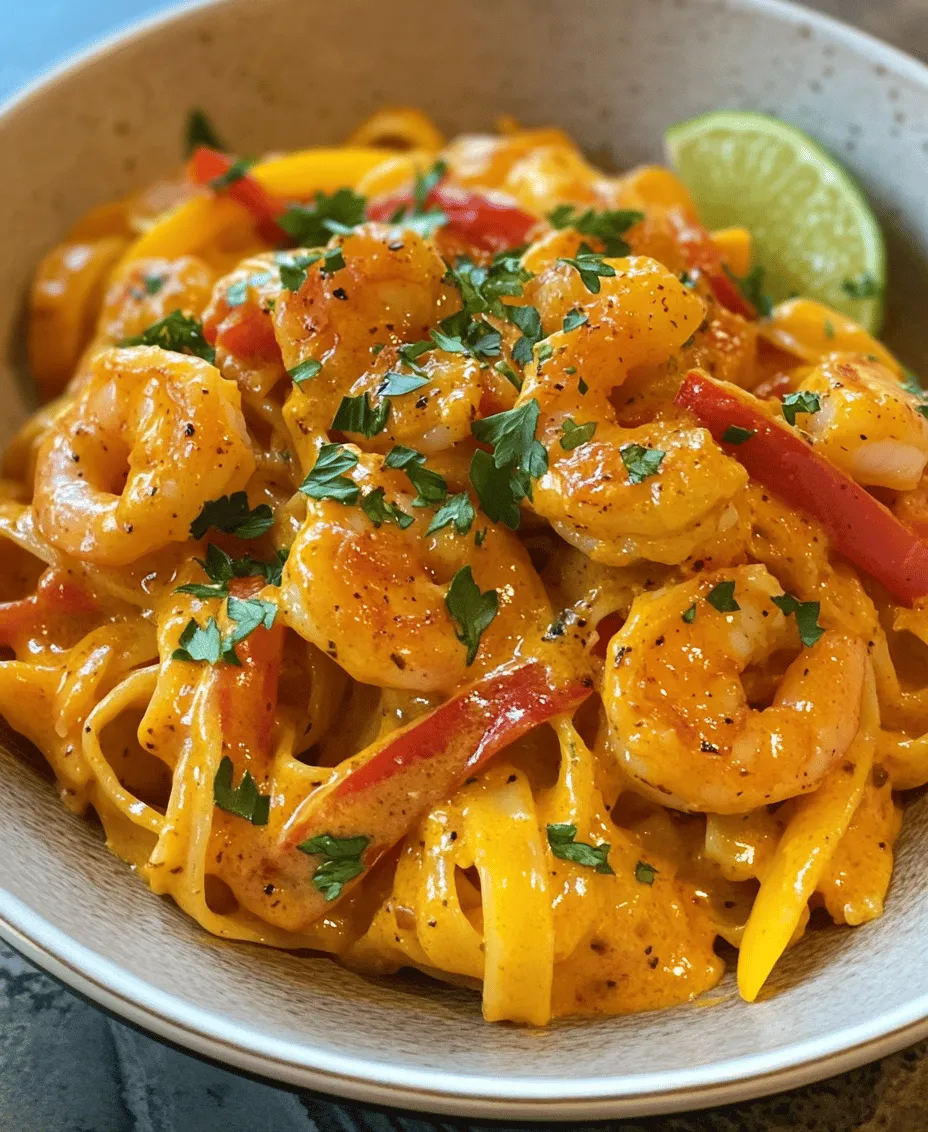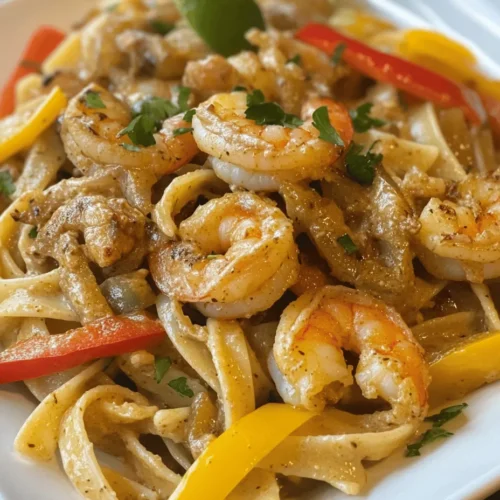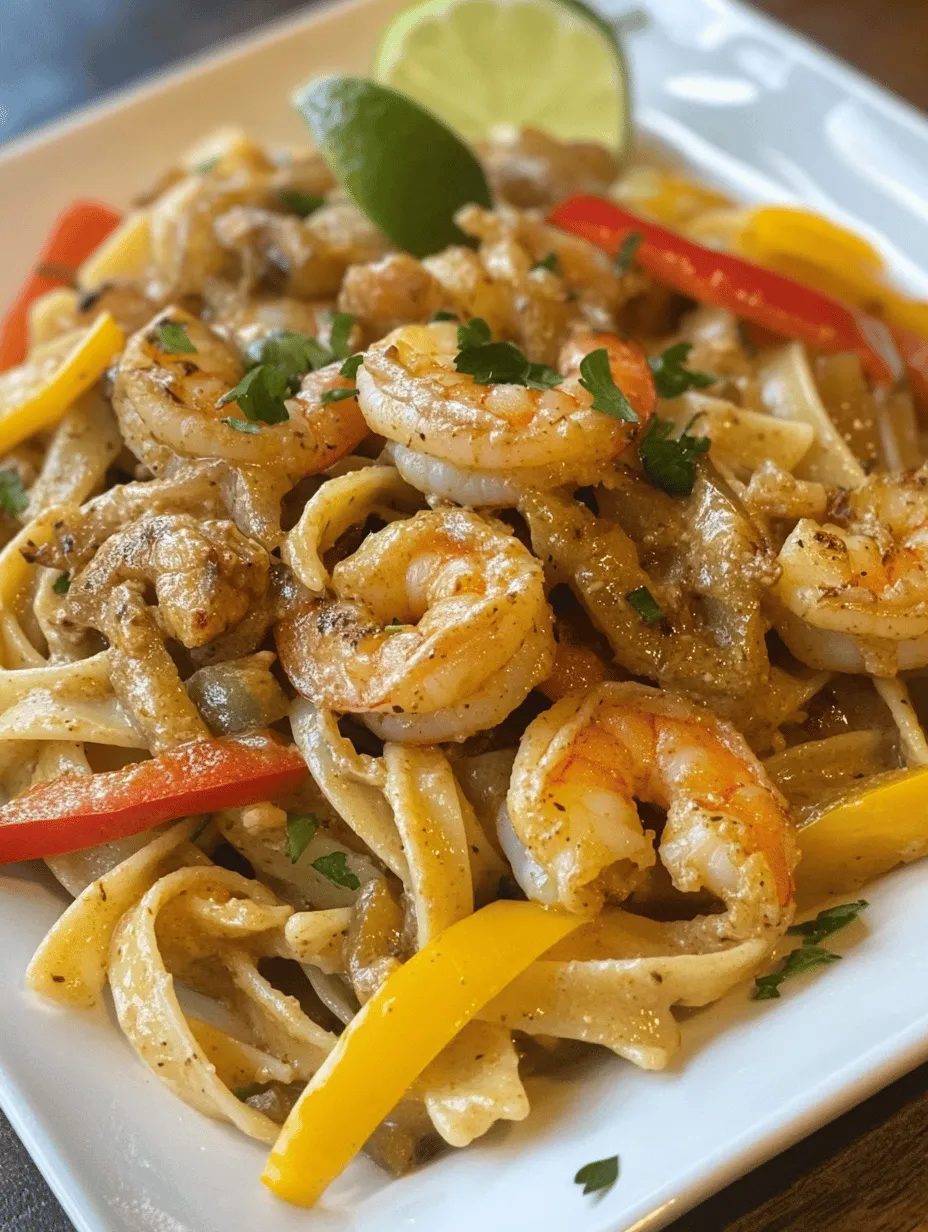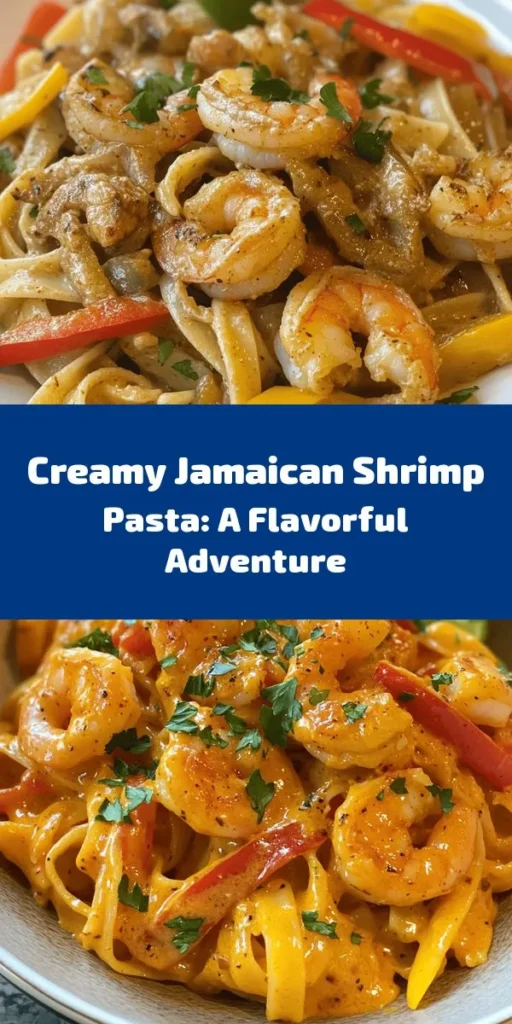Introduction
Jamaican cuisine is a vibrant tapestry of flavors, colors, and aromas, showcasing a rich cultural heritage that reflects the island’s history and diversity. Among the myriad of dishes that define this culinary paradise, Jamaican Shrimp Pasta stands out as a delightful fusion that marries the essence of Caribbean flavors with the comforting familiarity of Italian cooking. This dish features succulent shrimp, creamy coconut milk, and a touch of Jamaican jerk seasoning, creating a symphony of taste that transports you to sun-kissed beaches and tropical breezes.
The genesis of Jamaican Shrimp Pasta stems from the creative spirit of home cooks and chefs who have embraced the island’s rich agricultural bounty while incorporating international influences. This modern dish represents a culinary dialogue between the Caribbean and Mediterranean, embodying the harmonious blend of ingredients that both regions offer. In this article, we’ll delve into the origins of this delectable dish, explore the key ingredients that give it its unique character, and provide you with detailed step-by-step instructions to recreate this creamy delight in your own kitchen.
The Flavor Profile of Jamaican Shrimp Pasta
To truly appreciate Jamaican Shrimp Pasta, it’s essential to understand the flavor profile that sets it apart. At the heart of this dish are a few key elements that define Caribbean cuisine: bold flavors, aromatic spices, and fresh, vibrant ingredients.
Overview of Caribbean Flavors and Ingredients
Caribbean cooking is known for its use of fresh herbs, spices, and a variety of fruits and vegetables that contribute to its distinctive taste. Ingredients such as thyme, scallions, and Scotch bonnet peppers are staples that add depth and character to many dishes. The vibrant colors of Caribbean cuisine are not just visually appealing; they also indicate the use of nutrient-rich foods that are integral to the island’s culinary identity.
The Significance of Jerk Seasoning in Jamaican Cuisine
One cannot discuss Jamaican flavors without mentioning jerk seasoning. This iconic spice blend originated from the indigenous Taíno people and was later refined by Jamaican Maroons. Typically comprising allspice, thyme, garlic, and Scotch bonnet peppers, jerk seasoning offers a unique combination of heat, sweetness, and earthiness. In Jamaican Shrimp Pasta, this seasoning not only enhances the shrimp’s natural sweetness but also infuses the entire dish with a warm, aromatic profile that is quintessentially Caribbean.
The Role of Coconut Milk in Creating a Creamy Texture
Coconut milk is another hallmark of Caribbean cooking, known for its rich, creamy texture and subtle sweetness. It plays a pivotal role in Jamaican Shrimp Pasta, providing a luscious base that envelops the shrimp and pasta, making each bite a comforting experience. The combination of coconut milk and heavy cream creates a velvety sauce that beautifully complements the bold flavors of jerk seasoning, ensuring that the dish is as indulgent as it is flavorful.
Ingredients Overview
Now that we’ve set the stage for the flavor journey ahead, let’s take a closer look at the key ingredients that make Jamaican Shrimp Pasta a standout dish.
Linguine or Fettuccine Pasta: Types and Best Uses
When it comes to choosing the right pasta for this dish, linguine or fettuccine are excellent options. Both types of pasta have a flat shape that allows them to hold onto the creamy sauce, ensuring that each strand is coated in flavor. Linguine, with its slightly thinner profile, offers a delicate texture, while fettuccine provides a more substantial bite. Depending on your preference, either option will work beautifully in this recipe.
Fresh Shrimp: Benefits of Using Large, Peeled, and Deveined Shrimp
The star of this dish is undeniably the shrimp. For the best results, opt for large, fresh shrimp that are already peeled and deveined. Fresh shrimp offers a sweet, briny flavor that frozen shrimp simply cannot match. When cooked properly, shrimp should be tender and juicy, making it a perfect match for the creamy sauce. Additionally, using large shrimp ensures that every bite is satisfying and substantial, providing a delightful contrast to the pasta.
Aromatics: Onions, Garlic, and Peppers for Flavor Depth
Aromatic ingredients like onions, garlic, and peppers contribute significantly to the flavor depth of Jamaican Shrimp Pasta. Sautéing these ingredients at the beginning of the cooking process helps to build a robust foundation for the dish. Onions add sweetness, while garlic brings a savory note. Adding bell peppers not only enhances the flavor but also adds a pop of color that makes the dish visually appealing.
Coconut Milk and Heavy Cream: The Perfect Creamy Combination
The secret to achieving the desired creaminess in this pasta lies in the combination of coconut milk and heavy cream. Coconut milk provides natural sweetness and a rich texture, while heavy cream adds a luxurious mouthfeel. This combination ensures that the sauce is not only creamy but also has a balanced flavor profile that complements the spice from the jerk seasoning.
Jamaican Jerk Seasoning: Balancing Heat and Flavor
As previously mentioned, jerk seasoning is a cornerstone of the dish. Its complex flavor profile, which includes heat from Scotch bonnet peppers, sweetness from brown sugar, and aromatic spices, elevates the overall taste of the pasta. The key is to use the right amount of jerk seasoning to achieve a balance between heat and flavor—enough to provide a kick but not so much that it overwhelms the other ingredients.
Importance of Using Fresh Herbs and Spices for Authentic Taste
Finally, the use of fresh herbs and spices cannot be overstated. Fresh thyme, scallions, and even a squeeze of lime juice at the end can brighten the dish and enhance the overall flavor. Dried herbs can be convenient, but nothing compares to the intensity and freshness of using newly picked herbs. This commitment to quality ingredients is what makes Jamaican Shrimp Pasta a truly authentic representation of Caribbean cuisine.
Step-by-Step Instructions to Prepare Jamaican Shrimp Pasta
With a clear understanding of the ingredients, you are now ready to embark on the culinary adventure of making Jamaican Shrimp Pasta. Follow these detailed step-by-step instructions to ensure that your dish turns out perfectly.
Cooking the Pasta: Achieving the Perfect Al Dente Texture
Begin by bringing a large pot of salted water to a boil. The salt is crucial as it enhances the flavor of the pasta. Once the water is at a rolling boil, add your linguine or fettuccine. For the best results, refer to the package instructions for cooking time, typically around 8-10 minutes. To achieve an al dente texture, taste the pasta a minute or two before the recommended cooking time is up. The pasta should be firm to the bite but not hard, as it will continue to cook slightly when combined with the sauce.
Once the pasta is cooked to perfection, reserve a cup of the pasta water and then drain the rest. Do not rinse the pasta, as this will wash away the starch that helps the sauce adhere. Set the drained pasta aside while you prepare the sauce.
Sautéing the Vegetables: Tips for Enhancing Flavors
In a large skillet, heat a tablespoon of olive oil over medium heat. Once the oil is shimmering, add finely chopped onions and sauté them for about 2-3 minutes until they become translucent. Next, add minced garlic and diced bell peppers, cooking for another 2 minutes. The aim here is to soften the vegetables and release their flavors without browning them.
For an extra layer of flavor, consider adding a pinch of salt during this step, as it helps to draw out the moisture from the vegetables. Additionally, you can sprinkle in a teaspoon of fresh thyme at this stage to infuse the dish with its aromatic scent.
Cooking the Shrimp: Ensuring Tender and Juicy Results
After the vegetables are sautéed, it’s time to add the star ingredient: the shrimp. Increase the heat slightly and add the peeled and deveined shrimp to the skillet. Season them with a pinch of salt and pepper, and then sprinkle the jerk seasoning evenly over the shrimp.
Cook the shrimp for about 2-3 minutes on each side, or until they turn a beautiful pink color and are opaque. Be careful not to overcook the shrimp, as they can become tough and rubbery. Once cooked, remove the shrimp from the skillet and set them aside; they will be added back in later when you combine everything.
Creating the Sauce: How to Achieve the Right Consistency
In the same skillet, reduce the heat to medium-low and pour in a can of coconut milk. As the coconut milk begins to warm, stir in the heavy cream, creating a creamy base for your sauce. Allow the mixture to simmer gently for about 3-5 minutes, letting the flavors meld together.
To achieve the right consistency, you can adjust the thickness of the sauce by adding some of the reserved pasta water. If the sauce is too thick, gradually incorporate the pasta water until you reach your desired consistency. Taste the sauce and adjust the seasoning if necessary, adding more jerk seasoning or salt to suit your preferences.
Once the sauce is creamy and well-seasoned, return the shrimp to the skillet, along with the cooked pasta. Gently toss everything together, ensuring that each strand of pasta is coated in the luscious sauce.
As you prepare to serve this Jamaican Shrimp Pasta, the aroma will transport you straight to the tropics, with every ingredient working in harmony to create a dish that is both comforting and exotic.

Combining Pasta and Sauce: Techniques for Even Coating
Once your pasta is cooked al dente and your creamy shrimp sauce is ready, it’s time to bring them together for a delightful culinary experience. To achieve an even coating of the sauce on the pasta, follow these steps:
1. Reserve Pasta Water: Before draining the pasta, make sure to reserve about a cup of the starchy pasta water. This water is instrumental in adjusting the sauce’s consistency and helps it cling better to the pasta.
2. Combine in the Right Order: In a large mixing bowl or directly in the skillet where you prepared the sauce, add the drained pasta. Pour the creamy shrimp sauce over the pasta. The heat from the pasta will help to warm up the sauce further, ensuring that everything melds together beautifully.
3. Toss Gently: Using tongs or a spatula, gently toss the pasta and sauce together. Start by lifting the pasta from the bottom of the bowl and folding it over the sauce. This method prevents the pasta from breaking and ensures that every strand is coated. If the sauce seems too thick, add a little reserved pasta water, a tablespoon at a time, until you achieve your desired creaminess.
4. Taste and Adjust: Before serving, taste the pasta to check the seasoning. If it needs more salt or spice, this is the perfect time to adjust. Remember, the flavors will meld as it sits, so don’t be afraid to make it a bit bolder.
Finishing Touches: Adding Cheese and Seasoning for Optimal Flavor
After combining the pasta and sauce, the final touches will elevate this dish to new heights. Consider the following:
1. Cheese: Grated Parmesan or a similar hard cheese can be sprinkled generously over the pasta just before serving. Parmesan adds a salty, nutty flavor that complements the creaminess of the sauce. For a more Jamaican twist, consider using a bit of grated Jamaican cheddar, which has a unique flavor that pairs beautifully with the dish.
2. Seasoning: A sprinkle of freshly cracked black pepper and a pinch of salt will enhance the flavors even further. If you enjoy a bit of heat, consider adding a dash of cayenne pepper or a few dashes of hot sauce to give it a kick.
3. Herbs: Fresh herbs not only add flavor but also a burst of color. Finishing your pasta with chopped parsley or cilantro (or a combination of both) will provide a freshness that balances the richness of the sauce.
Serving Suggestions for Jamaican Shrimp Pasta
Presentation is key when serving your Jamaican shrimp pasta. Here are some tips to make the dish visually appealing:
1. Plating: Use a large serving bowl or individual plates to serve the pasta. Twirl the pasta with a fork or tongs to create a nest-like shape, which will make the dish look more inviting.
2. Garnishing: As mentioned earlier, garnishing with fresh herbs like parsley or cilantro adds a pop of color and enhances the overall flavor. Place a generous sprinkle over the top just before serving.
3. Lime Wedges: Serve lime wedges on the side. The acidity of the lime juice will brighten the dish and add a refreshing zing that complements the creamy sauce perfectly. Encourage your guests to squeeze the lime over their pasta just before eating for an extra flavor boost.
Nutritional Information
Understanding the nutritional value of your dish is essential for those mindful of their dietary intake. Here’s a breakdown of the typical nutritional content of Jamaican shrimp pasta:
– Calories: Approximately 400-500 calories per serving, depending on portion size and ingredients used.
– Protein: Shrimp is an excellent source of lean protein, providing about 20-25 grams per serving.
– Fats: The creamy sauce contributes to the fat content, ranging from 15-25 grams depending on the amount of cream and cheese used.
– Carbohydrates: Pasta typically contains around 40-60 grams of carbohydrates per serving, depending on the type of pasta used.
Health Benefits of the Ingredients Used
– Shrimp: Low in calories but high in protein and essential nutrients like selenium and vitamin B12.
– Cream: While it adds richness, using alternatives like low-fat cream or evaporated milk can reduce calories and fat content.
– Vegetables: Incorporating vegetables such as bell peppers and spinach not only adds color but also increases fiber, vitamins, and minerals.
When considering portion sizes, a standard serving is about 1 to 1.5 cups of pasta. Pairing this dish with a side salad can enhance its nutritional profile and provide a well-rounded meal.
Cultural Context of Jamaican Cuisine
Jamaican cuisine is a vibrant blend of flavors and influences, reflecting the island’s rich history and cultural diversity. The roots of Jamaican cooking can be traced back to the indigenous Taino people, but it has been significantly shaped by African, European, and Asian cultures over centuries.
1. Historical Influences: The arrival of enslaved Africans brought a variety of cooking techniques and flavors, including the use of spices and the importance of communal cooking. Over time, European settlers introduced new ingredients such as sugar and wheat, leading to the development of unique dishes.
2. Culinary Contributions: Today, Jamaican cuisine is known for its bold flavors, often characterized by the use of spices like allspice, ginger, and Scotch bonnet peppers. The influence of Indian and Chinese immigrants is evident in dishes like curry goat and chop suey, showcasing the island’s multicultural heritage.
3. Jamaican Shrimp Pasta: This dish embodies the fusion of Jamaican culinary traditions with Italian influences, highlighting how global cuisines can come together to create something unique and delicious. The creamy sauce and shrimp reflect the island’s seafood abundance, while the pasta adds an Italian twist, showing how Jamaican food continues to evolve.
Variations and Customizations
One of the beauties of Jamaican shrimp pasta is its versatility. You can easily customize it to suit your taste preferences or dietary needs:
1. Protein Substitutions: If shrimp isn’t your preference, consider substituting it with chicken or tofu for a vegetarian option. Chicken breast can be sautéed until golden and then combined with the sauce, while tofu can be marinated for added flavor.
2. Adjusting Spice Levels: The level of spiciness can be tailored to your liking. For milder flavors, reduce the amount of Scotch bonnet pepper or replace it with a milder chili. Conversely, for those who enjoy heat, feel free to increase the quantity.
3. Incorporating Seasonal Vegetables: Adding seasonal vegetables like zucchini, asparagus, or cherry tomatoes not only enhances the dish’s nutritional value but also adds vibrant colors and textures. Sautéing these vegetables briefly before adding them to the sauce will ensure they retain their crunch.
Conclusion
Jamaican Shrimp Pasta is not just a meal; it’s an experience that brings the vibrant flavors of Jamaica to your table. With its creamy sauce, perfectly cooked shrimp, and colorful vegetables, this dish is sure to impress anyone who tries it. Whether enjoyed on a casual weeknight or a special occasion, it promises a culinary journey that celebrates the best of both Caribbean and Italian cuisines. Embrace the tropical flavors and let this creamy delight transport you to a sunny beach in Jamaica.



